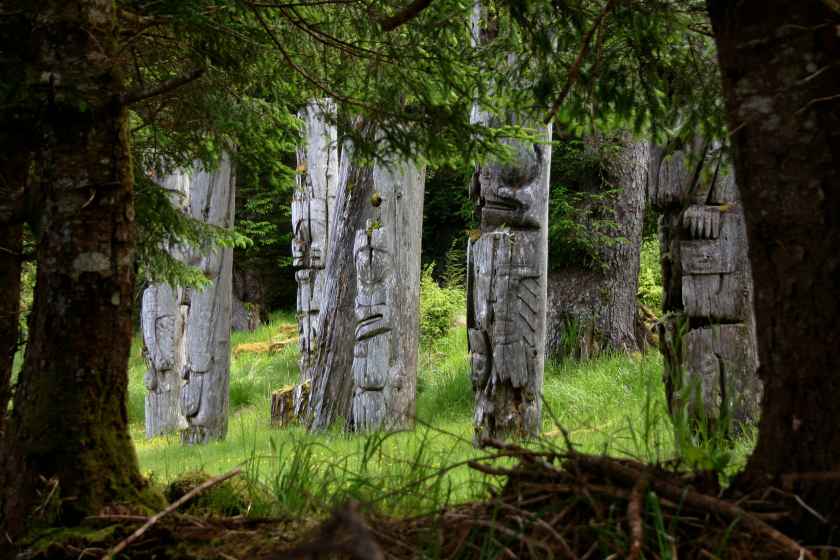Gwaii Haanas National Park Reserve and Haida Heritage Site, Canada: A UNESCO World Heritage Destination of Natural and Cultural Significance
Gwaii Haanas National Park Reserve and Haida Heritage Site, located in the southernmost part of Haida Gwaii (formerly known as the Queen Charlotte Islands) off the coast of British Columbia, Canada, is a region of profound cultural significance and exceptional natural beauty. The name "Gwaii Haanas" translates to "Islands of Beauty" in X̱aayda kíl, the southern dialect of the Haida language.

Geography and Natural Features
Gwaii Haanas encompasses an archipelago of 138 islands, with Moresby Island being the largest and Kunghit Island the southernmost. The area spans approximately 1,470 square kilometers (570 square miles) and includes diverse ecosystems such as temperate rainforests, coastal rainforests, and marine environments rich in biodiversity. The region is renowned for its towering moss-draped cedar and Sitka spruce trees, ancient totem poles, and a variety of wildlife, including bald eagles, bears, whales, porpoises, and sea lions.

Cultural Significance
The Haida people have inhabited Haida Gwaii for at least 14,000 years, with oral histories and archaeological evidence highlighting their enduring connection to the land since the retreat of glaciers and the arrival of the first trees. Gwaii Haanas is of profound cultural importance, featuring numerous Haida village sites, intricately carved totem poles, and longhouse ruins that embody the rich heritage and traditions of the Haida Nation.
A standout among these cultural treasures is the village site of SG̱ang Gwaay (Skedans), designated a UNESCO World Heritage Site in 1981. SG̱ang Gwaay is celebrated for its well-preserved totem poles and archaeological significance, offering a window into the spiritual and societal structure of the Haida people. This remarkable site serves as a testament to the Haida's deep connection with their environment and their artistic and cultural achievements.
History and Establishment
In the 1970s and 1980s, Gwaii Haanas faced threats from logging and resource extraction. In 1985, the Haida Nation designated the "Haida Heritage Site" to protect the area. This designation led to the creation of the South Moresby National Park Reserve in 1988, which was later renamed Gwaii Haanas National Park Reserve and Haida Heritage Site in 1993. The establishment of Gwaii Haanas was a result of collaborative efforts between the Haida Nation and the Government of Canada, culminating in the Gwaii Haanas Agreement, which emphasized the protection of the region's natural and cultural treasures.
Management and Governance
Gwaii Haanas is managed through a co-management model by the Gwaii Haanas Archipelago Management Board (AMB), comprising an equal number of representatives from the Haida Nation and the Government of Canada. This collaborative approach ensures that both Haida cultural values and conservation objectives are upheld. The AMB oversees all aspects of planning, operation, and management within Gwaii Haanas.

Biodiversity and Conservation
The park is a haven for diverse flora and fauna. The temperate rainforests are home to ancient trees, including towering cedars and spruces, which provide habitat for various species. The marine areas are rich in marine life, supporting populations of whales, porpoises, sea lions, and a variety of seabirds. Conservation efforts focus on preserving these ecosystems and the cultural heritage sites within the park.
Visitor Experience
Access to Gwaii Haanas is limited to boats and seaplanes, as there are no roads into the area. Visitors can explore the park through guided tours, kayaking excursions, and wildlife viewing, offering intimate experiences with the ocean and its creatures, as well as the primordial wilderness and culture of Gwaii Haanas' network of islands. The peak visitor season is from June through September.
Conclusion
Gwaii Haanas National Park Reserve and Haida Heritage Site stands as a testament to the harmonious relationship between the Haida people and their ancestral lands. Through collaborative management and a commitment to conservation, Gwaii Haanas preserves the rich cultural heritage and natural beauty of this unique archipelago for future generations.
0 Comment to "Gwaii Haanas National Park Reserve and Haida Heritage Site, Canada: A UNESCO World Heritage Destination of Natural and Cultural Significance"
Post a Comment